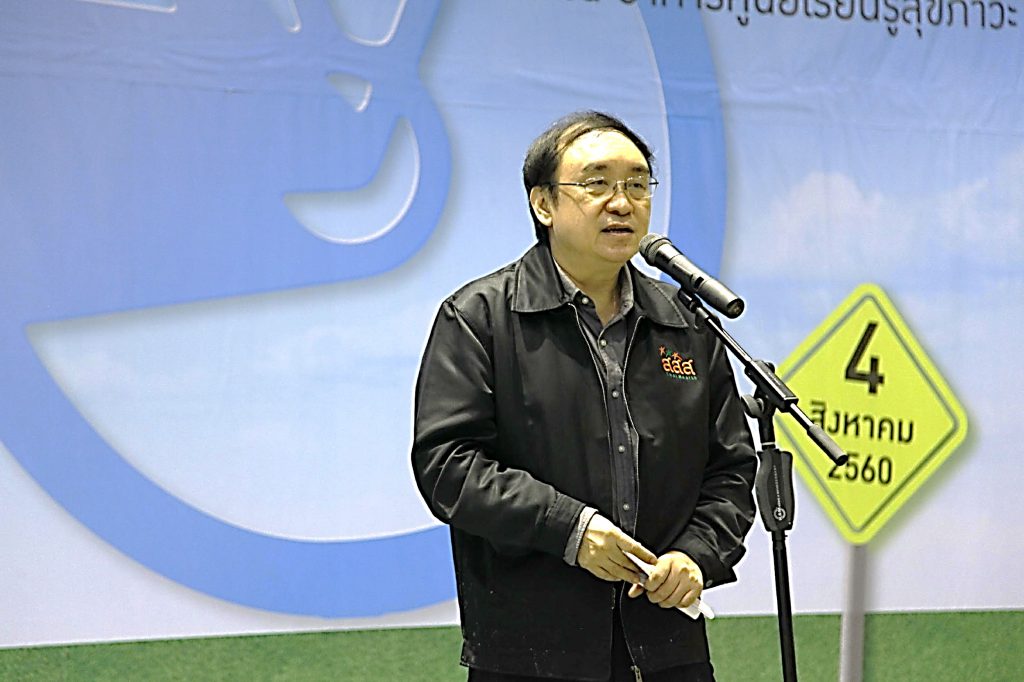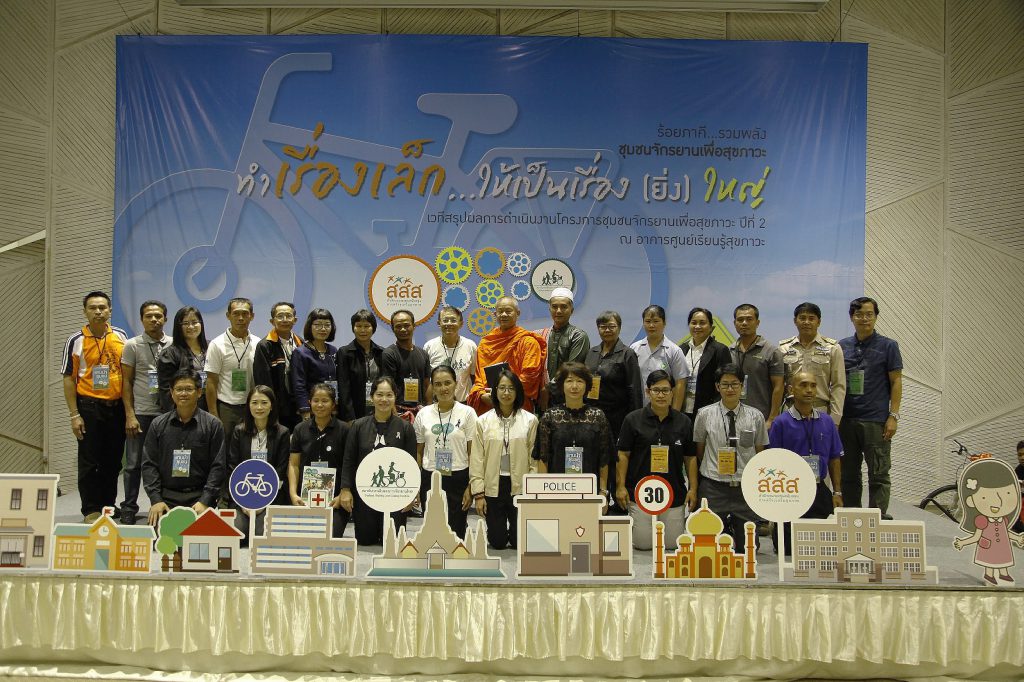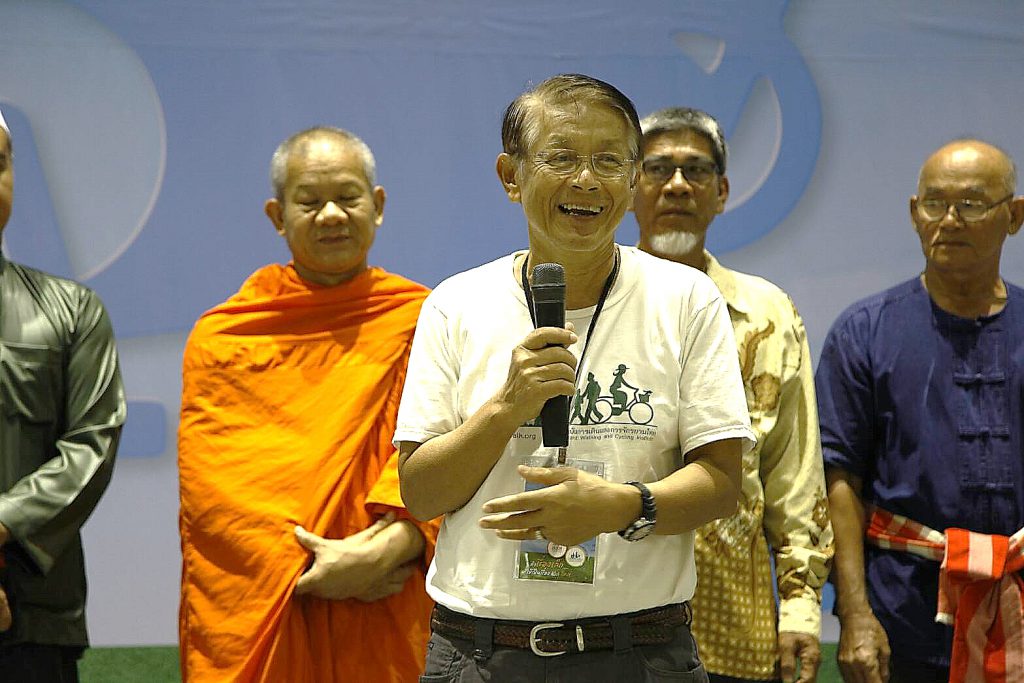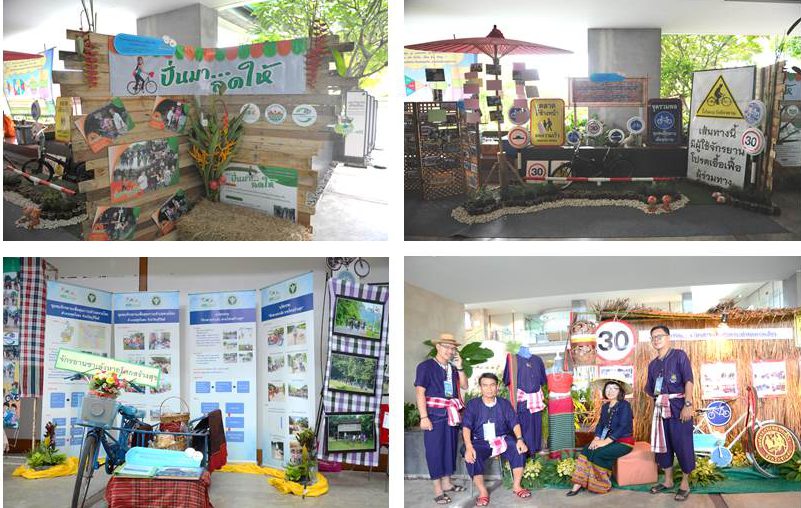Thailand Walking and Cycling Institute (TWCI) joins hands with Thai Health Promotion Foundation (ThaiHealth) to advocate cycling in daily life through cycling communities in all regions of Thailand with a goal to increase physical activity to no less than 80 per cent of their population within 2021, targeting 99 communities in 34 provinces.
On 4th August 2017, Thai Health Promotion Foundation (ThaiHealth) together with Thailand Walking and Cycling Institute (TWCI) Foundation organized a meeting, entitled “Tie partners, combine power of cycling communities together, to make little things great”, to conclude operation of the Cycling Communities for Health Project (Year II). The meeting was attended by representatives from 25 ‘model communities’, that have good practices in their process to build cycling communities which promote cycling in daily life, who came to present their ideas and experiences in order to share with and inspire other like-minded communities all over the country.
Dr. Supreeda Adulyanonda, ThaiHealth Manager, said that advocating creation of cycling communities was a big challenge as its process involved transformation of community members’ way of life, adjustment of the environment, especially infrastructure, necessary to facilitate cycling in the communities, and organizing creative activities that addressed cycling in the communities. Throughout the past year, Thai Health together with TWCI and local partners had worked to promote cycling communities, support local people to use bicycle as a means of transport in their daily life, resulting in cycling communities being built in 99 areas in 34 provinces all over the country.

(Dr. Supreeda Adulyanonda, ThaiHealth Manager)
The ThaiHealth Manager explained that four main factors led to success in the process to create a cycling community. They were readiness of local leaders, positive responses by the community, consent by related government agencies, and supports from private sector. These four factors contributed to emergence of the environment that facilitated use of bicycle, making the people feel safe and comfortable to use bicycle as a means of transport in their daily life. Cycling in daily life can importantly help Thailand achieve a goal that at least 80 per cent of its population have enough physical activity in 2021.
In this meeting, communities that could be models for good practices made presentations and shared their experiences on four main issues as follows:
1. Making use of local culture and environment as a foundation: Koh Libong (Libong Island) was raised as an interesting example. Being an island, the only way it could be reached from mainland is by passenger boats; there was no regular ferry that can transport cars. Existing few roads on the island had been paved with cement blocks, which deterred speeding. Local people had an agreement not to use motorcars for commuting; few pick-up trucks were allowed to use only for transport of goods and in emergency cases. These restrictions have become positive factor to promote cycling in daily life. Cultural/historical heritage together with natural resources in forms of beaches, forests and dugongs, which use the shallow sea around the island as their habitat more than anywhere in Thai waters, also become ecotourism attraction, especially with bicycle.
2. Building critical mass; people’s participation leads to innovation: Ta Khan community in Rayong Province is an example where shops participating in cycling promotion activities create incentives for community members to use bicycle by offering concessions to those who cycle to buy their merchandises.
3. Integrating works/tasks and binding partners: A clear example is a community in Songkhla Province where a local female leader has used cycling promotion as an important tool to carry out development activities/projects in the community. Cycling promotion was used to turn young people away from addiction to (sedentary) games to doing constructive activities. Community members can do a good deed by donating used bicycles to poor children. Public health care volunteers ride bicycle to make home visits / do outreach activity.
4. Bike plan to local policy: Even though each community has different capital/resources, to make cycling promotion sustainable, communities involved need to make their cycling promotion plan known to and adopted by local administrative organisations and related local government agencies as their plan and policy, so that works could be carried out continuously and cooperation from all sectors could be mobilized.
 leaders of the cycling community for health from 25 ‘model, that have good practices.
leaders of the cycling community for health from 25 ‘model, that have good practices.
A cycling community for health advocated by Chaiyaphum Provincial Municipality in Chaiyaphum Province was highlighted as a cycling community that had concrete work plan for cycling promotion. They raised local public awareness to make use of bicycle in daily life widely accepted. Cooperation was built with other road users to change their driving behaviours to drive slower and lower speed limit was introduced. Volunteers visited people’s home to publicise the project. This led to their work plan being integrated into mission and policy of the local administrative organisations and cycling promotion was a part of all activities of the municipality. Activities were developed to encourage people of all ages to cycle. For example, “Young people with a heart of development worker” was an activity/project that children and youth in the community used bicycle as a tool to do their voluntary community development works.
Mr. Chumroon Tangpaisalkij, TWCI Director, said that the meeting was intended to be a stage where successes of communities were showcased, so that they could proudly present their products that they had worked together throughout the year out of their own design.This is another side of the project’s successes which aimed to promote, support and develop capacity of the communities to be able to manage their own area.

(Mr. Chumroon Tangpaisalkij, TWCI Director)
Ten cycling communities took their prop to the venue to set up booths to tell stories of their works. Had Sieo Sub-District Municipality in Sukhothai Province presented how cycling had been promoted consistently with traditional culture of Thai Puan people there. Pasak Sub-District Municipality in Lamphun Province used cycling promotion for environment management by recycling discarded materials to make signs for road safety. Nong Larn Sub-District Municipality in Kanchanaburi Province’s work to promote cycling in Nong Mai Kaen community were presented by a whole team of municipality administration and Buddhist monks from local temple. They employed a simple but powerful strategy of tripartite cooperation between community, temple and school to promote cycling. Their outstanding outputs were asking Buddhist temple congregations to give alms in form of bicycle, a ‘bicycle clinic’ and a ‘bicycle bank’. Bung Kei Sub-District Hospital in Nakhon Nayok Province which promoted cycling in Bung Kei community presented their methods to ‘cycle for changes’. Ta Khan cycling community in Rayong Province worked with shops in the community to adopt an incentive of which customers who cycle to buy merchandises would enjoy concessions, resulting in nearly all community members subscribing to this scheme. Chaiyaphum Town Municipality in Chaiyaphum Province applied a tradition of this one-thousand-year-old town to mobilise young people to become “one-thousand-year cyclists”, being volunteers to develop their community, building intimacy between the people and the municipality. Baan Fang Sub-District Municipality in Khon Kaen Province worked wonder with small communities, which in the beginning only wanted to be given free bicycles, to have young people as cycling guides, effectively build leadership among children. Communities in Hye Sok Sub-District, Phutthaisong District, Buriram Province, enabled old people in the communities who had difficulties to walk to enjoy going around again by tricycle. Na thom cycling community in Phatthalung Province used cycling as a tool to create activities that family members could do together, turning them away from risky behaviours, and thus build good family relations. Finally, a cycling community in Charoenphon sub-District in Nakhon Sawan Province had a strong leader whose symbol was a ‘Big Bicycle’ to act as a model for community members to follow.

Booths to tell stories of their works
Ms. Penchan Boonthung, a leader of the cycling community for health in Hye Soke Sub-District, talked proudly of her involvement in the cycling community project of which a key product was called “no sadness, happy tricycle” which enabled old people to travel around. “Previously, old people and people with disability who could not use bicycle could only travel on goods trolley kindly helped push by other people. Having this project with a clear work plan and a strong project committee, we came up with this innovation, the ‘no sadness, happy tricycle’, of which old and disabled people could use to visit bed-ridden patients, go to a school for old people, and visit neighbours, for example. This innovation enabled old people to take part more in activities in the community. They did not feel lonely, had better life quality, had vehicle that they could use to travel conveniently and safely in daily life with less expenses and thus more money in hands.”
Mr. Banleng Sainsak, a village committee member of village no.4, Baan Luk, Pasak Sub-District, Meaung Lamphun District, Lamphun Province, told us that his community knew well about environment management and used discarded materials to make signs for road safety in two languages, Thai and Thai Yai (Shan), as people with several different ethnicities resided in the area. “This project is useful all round. Apart from health benefits, it helps create unity in the community when people turn to concern about other people’s health. With ThaiHealth’s project, we turned to focus on making roads in our community that were good for regular cycling safe. We recycled discarded/non-use materials, such as tables and trays, to make safety signs in two languages and install them everywhere in the village, including small lanes.”
 The leader of the cycling community for health in Hye Soke Sub-District and Pasak Sub-District
The leader of the cycling community for health in Hye Soke Sub-District and Pasak Sub-District
The meeting attracted interests from other sectors, especially Designated Areas for Sustainable Tourism Administration (Public Organization). Mr. Krit Phumsuwan, Director of Plan Administration Section, Office of Designated Area of Pattaya City and Related Areas, pointed out that before promoting tourism by attracting tourists to use bicycle to visit a community, people in the community must use bicycle in their daily life as a way of life, so that they are familiar with cycling, seeing it as something ordinary, not alienated. When community members use bicycle, it would be easier to do other things with bicycle, whether it is tourism promotion or environment management. The organization is glad to work together with and support communities that are ready to develop cycling community for tourism in the Eastern Region and Central Region.
*******************************************************************************
For more information, please contact ThaiHealth’s Public Relations Team, Tel: 081 628 5141, 081 498 7932

